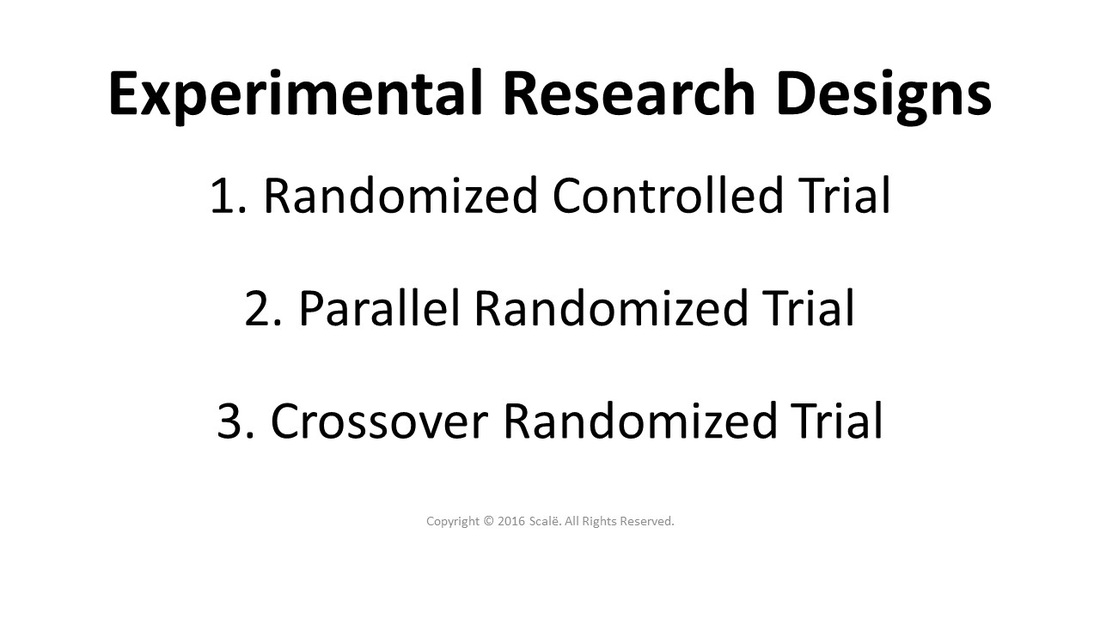Experimental research designs
True experiments are considered the gold standard for generating causal effects
Experimental research designs generate the highest level of applied clinical evidence. The use of random selection and random assignment in experiments yields comparison groups that are "eqiupoise" or equal/similar at baseline. Differences between treatment groups at baseline are thought to occur purely by chance as a result of randomization. Randomization also accounts for any confounding variables that affect the relationship between predictor and outcome variables.
In order to conduct a true experiment, researchers must have a rigorous and standardized methodology that can be replicated in other study environments. "Intention-to-treat" analysis, where study participants are analyzed in the group they were randomly assigned to at the beginning of the experiment. Blinding of participants, clinicians, and researchers helps to reduce observation biases.
With all of the aforementioned empirical complexity, experimental research designs can yield causal effects, This means that researchers can assume, under the rigorous and standardized methods being valid and credible, that a predictor can cause an outcome.
There are several experimental research designs that can be used in applied research.
In order to conduct a true experiment, researchers must have a rigorous and standardized methodology that can be replicated in other study environments. "Intention-to-treat" analysis, where study participants are analyzed in the group they were randomly assigned to at the beginning of the experiment. Blinding of participants, clinicians, and researchers helps to reduce observation biases.
With all of the aforementioned empirical complexity, experimental research designs can yield causal effects, This means that researchers can assume, under the rigorous and standardized methods being valid and credible, that a predictor can cause an outcome.
There are several experimental research designs that can be used in applied research.
Types of experimental research designs
The Randomized Controlled Trial (RCT) is considered the "gold standard" methodology for establishing the efficacy or detriments of treatments and drugs.
Parallel Randomized Designs are RCT trials where participants receive only one treatment or drug and stay in their original group for the entire study.
Crossover Randomized Designs are RCT trials where participants are switched, or crossover, from the treatment group to the control group, and from the control group to the treatment group, after a washout period.
Important components of experimental research designs
Random selection is a part of experimental and quasi-experimental research designs where members of a given population have an equal chance of being chosen for participation in a research study.
Random assignment is a part of experimental research designs where randomly selected participants have an equal chance of being placed in treatment or control groups.
Intention-to-treat analysis means that randomly selected and assigned study participants are assessed in the treatment or control group they were initially assigned to at the beginning of an experimental trial.
Blinding study participants is a method employed in experimental research designs to reduce observation bias associated with patients, clinicians, and researchers.
There are several different methods used to randomly select and assign study participants in experimental research designs.
Click on a button below to continue.
Statistician For Hire
DO YOU NEED TO HIRE A STATISTICIAN?
Eric Heidel, Ph.D. will provide statistical consulting for your research study at $100/hour. Secure checkout is available with PayPal, Stripe, Venmo, and Zelle.
- Statistical Analysis
- Sample Size Calculations
- Diagnostic Testing and Epidemiological Calculations
- Psychometrics

